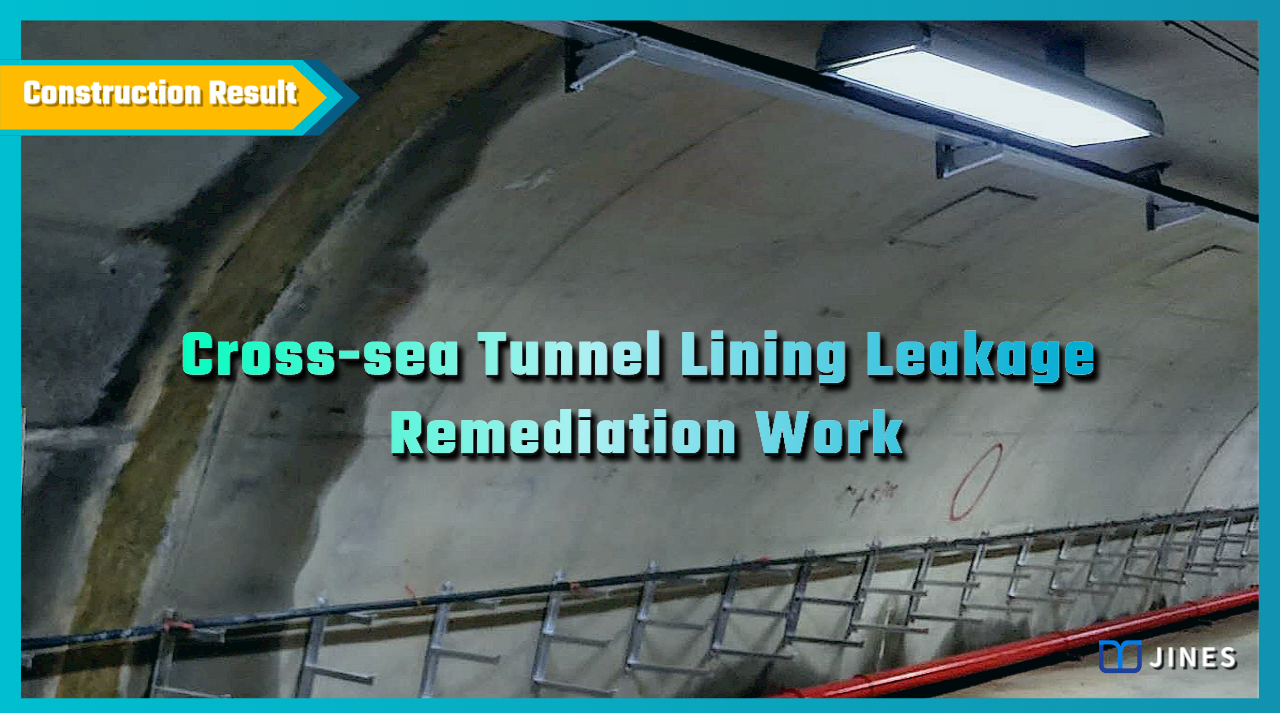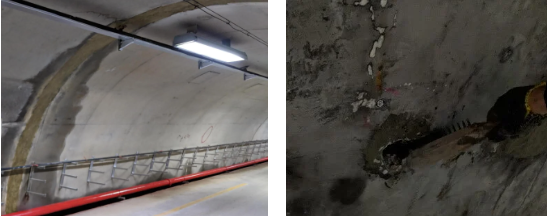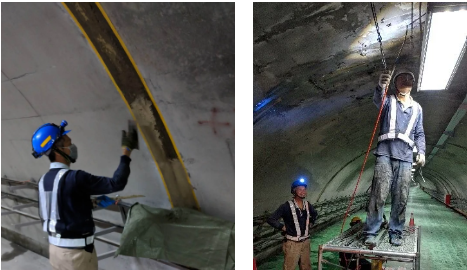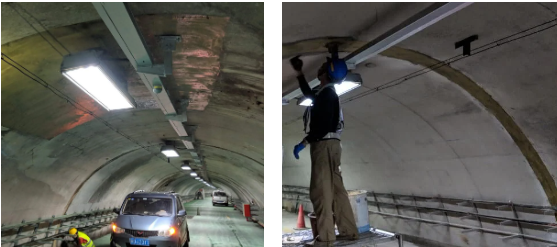
CROSS-SEA TUNNEL LINING LEAKAGE REMEDIATION WORK
Construction joints, honeycombs and faulty concrete leakage and repair case.
1. Project Background
A cross-sea tunnel in South China was constructed using the undercut method. After the tunnel lining was poured and the formwork was removed, it was found that there was leakage at annular construction joints, concrete spalling and serious honeycomb phenomena at localized positions.
After the general contractor sent staff to carry out cement grouting, water-swelling polyurethane injection and surface soil treatment, the water leakage phenomenon did not improve but became increasingly serious.
In order to ensure the safety of long-term use of the tunnel and the timely completion and acceptance, the contractor specially commissioned Fujian Jines Engineering Technology Co., Ltd. to carry out renovation planning and leakage prevention operations.

―
2. Solution
Because the depth of the cross-sea tunnel changed in a curve, there were many types of defects of different scale. The seepage water was saline and alkaline, long-term infiltration would lead to corrosion of rebars and deterioration of concrete, resulting in potential public danger.
According to the on-site investigation, the areas with more serious water leakage were mostly located in both sides of the soil-rock interface sections. When planning the solution, the concrete defects were divided into the following types:
(1) annular leakage of construction joints
(2) water-permeable concrete honeycomb;
(3) non- water-permeable concrete spalling;
(4) non-water-permeable concrete honeycomb, and so on.

―
3. Works Design
Due to the high water seepage pressure due to lining defects, cement-based grout was not suitable for use. After careful evaluation by experts, it was decided to use resin grout and resin mortar with high adhesion, short curing time and high strength after curing as the main repair materials.
The relevant construction design was planned as follows according to the defect conditions:
(1) Annular construction joints leakage. The cross-oblique hole grouting method was to be adopted, and self-expanding and non-expanding rigid resin grout to be used for secondary grouting to achieve a permanent water-stop effect.
(2) Water-permeable concrete honeycomb. A. Knock out loose aggregates on the honeycomb surface, and carry out square off of the knockout range; B. Use high pressure water gun to remove surface debris and dust; C. Non-soluble hydroactive resin injection on the water-facing surface of the lining to water-stop; D. Surface coating with hydrophilic epoxy resin; E. The middle section of the honeycomb to be filled with non-soluble rigid resin to fill the honeycomb voids and bond the loose aggregate; F. Use resin mortar to fill the knocked-out area and carry out surface treatment.
(3) Stripping off the water-free concrete. A. Use equipment to knock out the spalled concrete to reach the position of intact concrete and carry out squaring off of the knockout range; B. Use high pressure water gun to remove surface debris and dust; C. Coat the surface with epoxy resin interface adhesive; D. Use resin mortar to fill the knockout area and carry out surface treatment.
(4) Water-impermeable concrete honeycomb. A. Knock out loose aggregate on the honeycomb surface, and carry out squaring off in the knockout range; B. Use a high-pressure water gun to remove surface debris and dust; C. The surface is coated with hydrophilic epoxy resin; D. The middle section of the honeycomb is filled with non-soluble rigid resin to fill the honeycomb pores and bond the loose aggregate; E. Use resin mortar to fill the knockout area and carry out surface treatment.

―
4. Works Process
The undersea tunnel had many leakage points and of different character. This vehicle tunnel was a major project in the area, having 6 lanes with a designed service life of 100 years.
The quality of the repair adhesive materials and resin mortar had to meet the design requirements: the minimum post-curing requirements of adhesive strength >61.2kgf/cm2; compressive strength >300kgf/cm2. In order to make the construction quality higher than the design requirements, some materials and pouring equipment needed to be imported, which added to the project operation time.

―
5. Results
Since this project was part of the defect repair work after main project completion. The number of actions was large and the scale and type varied.
In addition, the technology selected by the general contractor in the early stages was not able to achieve the intended effects, resulting in increase in construction time and changes in the existing situation, which further increased the urgency and difficulty of the operation.
With the concerted efforts of the technical staff of Jines Construction Taiwan and China Mainland companies, the project difficulties were overcome one by one, and the commissioned work was successfully completed within the contract period.
After the contractor unit experts sent personnel to check and confirm that there was no water seepage and dampness, the task of rectifying leakage in the lining of the cross-sea tunnel was verified as successfully completed.

―
Cross-sea Tunnel Lining Leakage Remediation Work
將下載檔案寄至:
・More Construction Result Sharing
Contact us:+886 2769-2355
Copyright ©Jines Construction Co.,Ltd